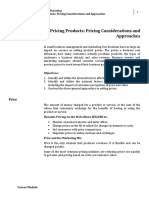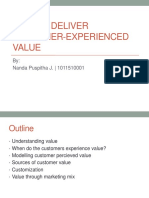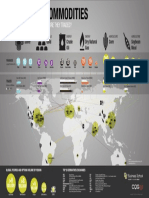What Is Value Management V1 11082012
What Is Value Management V1 11082012
Uploaded by
Kris NauthCopyright:
Available Formats
What Is Value Management V1 11082012
What Is Value Management V1 11082012
Uploaded by
Kris NauthOriginal Title
Copyright
Available Formats
Share this document
Did you find this document useful?
Is this content inappropriate?
Copyright:
Available Formats
What Is Value Management V1 11082012
What Is Value Management V1 11082012
Uploaded by
Kris NauthCopyright:
Available Formats
What is Value Management?
(And why you should care)
November 2012
A position paper from an open group of value management practitioners and consultants.
(See final page for participants.)
“The final question needed in order to come to grips with business purpose and
business mission is: “What is value to the customer?” It may be the most important
question. Yet it is the one least often asked. One reason is that managers are quite
sure that they know the answer. Value is what they, in their business, define as
quality. But this is almost always the wrong definition. The customer never buys a
product. By definition the customer buys the satisfaction of a want. He buys value.”
Peter Drucker, Management: Tasks, Responsibilities, Practices, 1993
Value Management: The management discipline of providing value to customers while ensuring that
providing value results in profit. Value management is a holistic approach that
results in alignment between product management, marketing, pricing, sales
and other business functions. The goal is sustainable and profitable revenue
growth.
Popular Tags for Twitter, LinkedIn and Google+
#valuemgmt #valueprop #pricing #marketing #sales #innovation #proddev
What is Value Management? (And why you should care.)
Creative Commons (cc) CC BY-ND 3.0 2012
By the Value Management Advocates
Page 1
Value management and its related disciplines have become a hot topic in the business press, within
leading companies and among consultants. Advocates, and we are among them, assert that value
creation and capture can and should be what companies optimize. By value is meant the value provided
to customers, not the value extracted from customers or shareholder value. Value management is a
holistic discipline that supports the cycle of Create → Communicate → Capture → Assess Customer
Value, all based on a foundation of Understanding. This cycle is sketched in Figure 1: The Value
Management Cycle.
Figure 1: The Value Management Cycle
What is Value?
Value can be a slippery term and it is used in many different ways. In value management the term is
understood as follows:
Value is relative to an alternative – value cannot be judged in isolation.
Value is composite and decomposable – value can be analyzed into a set of value drivers.
There is more than one aspect of value – in B2B the most important aspect is the economic, but
other aspects such as the emotional, environmental and social value can also be considered.
Value can be quantified – economic value can be quantified in a currency, other aspects have
their own forms of quantification such as Quality Adjusted Life Years in healthcare or Carbon
Footprint for green solutions.
What is Value Management? (And why you should care.)
Creative Commons (cc) CC BY-ND 3.0 2012
By the Value Management Advocates
Page 2
The standard way to quantify economic value is shown in Figure 2: A Standard Economic Value Model.
Figure 2: A Standard Economic Value Model
There should be a mapping from the value metric (the way in which the customer gets value) to the
pricing metric (the way in which the seller charges for value). For example, the value of a surface coating
may derive from the area covered, while the price may be quoted in volume.
Value management relies on multiple streams of information from inside and outside the company.
Both internal and external perspectives are necessary. Information about customers, competitors,
demand, offers, costs and production constraints are all used in value management.
How will Value Management benefit my company?
Value management delivers profitable growth. It does so in the following ways:
Innovation is focused on products and services that provide value to the customer
(innovation that does not provide additional value relative to the best alternatives is money that
is thrown away)
Markets are segmented and pricing architecture structured around how the customer gets value
(this helps to maximize prices across the full range of potential customers)
Value is communicated in marketing messages
(so that messages can rise above the noise of generalized claims)
Prices are based on how and how much value customers get from your solution
( helping to manage discounting and commoditization pressure)
Sales negotiations are shifted from demands about price to tradeoffs on value
(controlling discounting and managing costs)
What is Value Management? (And why you should care.)
Creative Commons (cc) CC BY-ND 3.0 2012
By the Value Management Advocates
Page 3
Value management shifts innovation from a feature-cost orientation to a customer-value orientation as
is shown in Figure 3: Moving to a Customer-Value Orientation.
Figure 3: Moving to a Customer-Value Orientation
What disciplines are based on value management?
Value management is being applied with great success in many sectors, from specialty chemicals and
building materials, to software and medical technology. It is applicable anywhere there is meaningful
differentiation between offers for buyers. It is primarily used in business-to-business (B2B) but can be
applied in business-to-consumer (B2C) when economic factors shape buying decisions. And remember
that for a consumer goods company, selling to a distributor or retailer is a B2B relationship.
Value-Based Marketing Marketing based on insights about customer value. This can
include everything from segmentation and targeting to the
construction of specific value messages.
Value-Based Pricing A Value-Based Price is designed and communicated such that all
parties understand, recognize and accept the distinctive worth
of products and services purchased in the transaction and
participate optimally in the gains created by their use. Pricing
metrics are based on or can be converted to value metrics.
Offers are constructed so that customers that receive similar
amounts of value in similar ways are in the same price segment.
Discounting policies are based on differences in differentiation
value or on decisions to invest in a target customer or segment.
What is Value Management? (And why you should care.)
Creative Commons (cc) CC BY-ND 3.0 2012
By the Value Management Advocates
Page 4
Value-Based Product Management The use of customer value to shape decisions on product and
feature investment and to guide understanding of the target
customer’s business needs. One can begin product
development by creating a ‘target value model’ and then
validate this aspiration. Value models are also used in many
stage gate processes. The value drivers in the models can be
used in market segmentation.
Value-Based Selling Customers are targeted based on value drivers and
differentiation value. Value messages (based on value drivers)
are used in the sales process. Information about customers and
competitors that can be used to evolve value models is
captured in the selling process. Offers are constructed and
prices negotiated based on differentiation value.
What should I do next?
Join the Professional Pricing Society Group on LinkedIn and engage in the conversation.
Read one or more of the books on the field.
Contact one of the people on the next page.
What is Value Management? (And why you should care.)
Creative Commons (cc) CC BY-ND 3.0 2012
By the Value Management Advocates
Page 5
Value Management Advocates
Ed Arnold Harry Macdivitt
Jerry Bernstein Gautam Mahajan
Patrick Campbell Augustin Manchon
Steven Forth Aaron Miller
Jim Geisman Reg Nordman
Adrienne Gordon Chris Provines
Andreas Hinterhuber Dick Sobel
John Hogan Mark Stiving
Chris Hopf Mike Wilkinson
Vernon Lennon III Ralph Zuponcic
Stephan Liozu
(Please contact Steven Forth if you would like to endorse this position paper and add your name to this
list steven.forth@gmail.com.)
What is Value Management? (And why you should care.)
Creative Commons (cc) CC BY-ND 3.0 2012
By the Value Management Advocates
Page 6
You might also like
- Form AIA 702 - 703 Pay ApplicationDocument2 pagesForm AIA 702 - 703 Pay ApplicationKris Nauth67% (3)
- Dollarizing Differentiation Value: A Practical Guide for the Quantification and the Capture of Customer ValueFrom EverandDollarizing Differentiation Value: A Practical Guide for the Quantification and the Capture of Customer ValueNo ratings yet
- Session 1 Milestone One-CapstoneDocument6 pagesSession 1 Milestone One-CapstoneArrow PhotoNo ratings yet
- 03 ValueDocument10 pages03 ValuebeckyNo ratings yet
- Marketing's Value To Consumers, Firms, and SocietyDocument35 pagesMarketing's Value To Consumers, Firms, and SocietySage MainNo ratings yet
- PricingDocument36 pagesPricingDan YosNo ratings yet
- ValueDocument27 pagesValueTauhid Ahmed BappyNo ratings yet
- Class 3Document60 pagesClass 3piyush varmaNo ratings yet
- Pricing Strat Mid ReviewDocument3 pagesPricing Strat Mid ReviewellainealbanioNo ratings yet
- Unit-1 p65Document10 pagesUnit-1 p65chander32616No ratings yet
- Week 012-Module Pricing Considerations and ApproachesDocument4 pagesWeek 012-Module Pricing Considerations and ApproachesCeejay0908No ratings yet
- 1 Intro Sales ManagementDocument35 pages1 Intro Sales Managementmy9870712888No ratings yet
- MKT Chapter-02Document37 pagesMKT Chapter-02ovirahman716No ratings yet
- Huber 2001Document11 pagesHuber 2001Vanessa CardosoNo ratings yet
- Pom ReviewerDocument18 pagesPom ReviewerFatima Shamira ArapNo ratings yet
- MKTG 201 Lecture 3-Chpt1-Creating & Capturing Customer Value-Part 2Document15 pagesMKTG 201 Lecture 3-Chpt1-Creating & Capturing Customer Value-Part 26ynkzmmcfvNo ratings yet
- Chapter 6 How To Deiver Customer Experience ValueDocument12 pagesChapter 6 How To Deiver Customer Experience ValueOrawan SangthongnirundornNo ratings yet
- Customer SegmentationDocument10 pagesCustomer SegmentationGirish GhorpadeNo ratings yet
- Class 1 Marketing OverviewDocument24 pagesClass 1 Marketing OverviewNikhil VallabhapuramNo ratings yet
- Value-Based Pricing Putting The Customer at The Centre of Price PDFDocument4 pagesValue-Based Pricing Putting The Customer at The Centre of Price PDFAwadh KapoorNo ratings yet
- Association, 2013) - This Definition Highlights Key Marketing PrinciplesDocument3 pagesAssociation, 2013) - This Definition Highlights Key Marketing PrinciplesJayashree JayaramNo ratings yet
- Handout 1Document52 pagesHandout 1Ash KetchumNo ratings yet
- Session 17 Pricing in Business MarketingDocument46 pagesSession 17 Pricing in Business MarketingKuldip BaravaliyaNo ratings yet
- Marketing Concept: Disampaikan: DR - Ibrahim Daud, MSDocument36 pagesMarketing Concept: Disampaikan: DR - Ibrahim Daud, MSAlfandi RahyuniNo ratings yet
- Marketing OrientationDocument46 pagesMarketing Orientationeljavico100% (1)
- Priciples of Marketing by Philip Kotler and Gary ArmstrongDocument41 pagesPriciples of Marketing by Philip Kotler and Gary Armstrongbugsosar100% (1)
- Sales & Marketing - Session01Document30 pagesSales & Marketing - Session01gurmeetsingh40810345No ratings yet
- NOTES - Marketing MGMTDocument92 pagesNOTES - Marketing MGMTPrabhuNo ratings yet
- Priciples of Marketing by Philip Kotler and Gary ArmstrongDocument45 pagesPriciples of Marketing by Philip Kotler and Gary ArmstrongnipscNo ratings yet
- Pricing StrategyDocument46 pagesPricing StrategyKunal Saini100% (1)
- Core Aspects of Customer Value & The Factors of Building Customer RelationshipsDocument10 pagesCore Aspects of Customer Value & The Factors of Building Customer RelationshipsShovon AhmedNo ratings yet
- EngManagement CompressedDocument229 pagesEngManagement CompressedMary Joy ManayagaNo ratings yet
- Wadhwani 5.1 & 5.2 - Pricing and MonetizationDocument26 pagesWadhwani 5.1 & 5.2 - Pricing and MonetizationSaikumar BunniNo ratings yet
- Chapter 14 - Pricing Strategy For Business MarketsDocument25 pagesChapter 14 - Pricing Strategy For Business Marketsdewimachfud100% (1)
- MGM3180 - Marketing (Kinderjoy)Document26 pagesMGM3180 - Marketing (Kinderjoy)Mazaya Dhiya HaniifahNo ratings yet
- Service Marketing AssignmentDocument12 pagesService Marketing AssignmentPrincess JennyNo ratings yet
- How To Deliver Customer-Experienced ValueDocument23 pagesHow To Deliver Customer-Experienced Valuenanda puspitha100% (1)
- Pricing Strategy Chapter 1Document42 pagesPricing Strategy Chapter 1Towhidul HoqueNo ratings yet
- 1 MarketingDocument113 pages1 MarketingalbgatmtyNo ratings yet
- MBA Week 4 Business ModelDocument88 pagesMBA Week 4 Business ModelOde BukolaNo ratings yet
- Product Policies A Comprehensive GuideDocument10 pagesProduct Policies A Comprehensive Guidemurugavel2299No ratings yet
- T5 Price Lecture & TutorialDocument54 pagesT5 Price Lecture & Tutorial19-B8-Nguyễn Gia HuyNo ratings yet
- 02what is Marketing2024canvasDocument37 pages02what is Marketing2024canvasHamna MillionNo ratings yet
- MP CH 1,2,5Document39 pagesMP CH 1,2,5Erlita KusumaNo ratings yet
- Product Management Lesson Pricing DecisionDocument4 pagesProduct Management Lesson Pricing DecisionRikatsuiii chuchutNo ratings yet
- AIRLINE MARKETING MANAGEMENT - Class NotesDocument20 pagesAIRLINE MARKETING MANAGEMENT - Class Noteskaifm890No ratings yet
- 01.Marketing Strategy Student CopyDocument35 pages01.Marketing Strategy Student CopydomyeriveraNo ratings yet
- Chapter 2-Value CreationDocument38 pagesChapter 2-Value CreationViên ThùyNo ratings yet
- Presentation On Marketing-Creating Customer Value and Engagement Course Name: Principles of Marketing Course Code:FIN-122 Course Teacher:MD - AlaminDocument22 pagesPresentation On Marketing-Creating Customer Value and Engagement Course Name: Principles of Marketing Course Code:FIN-122 Course Teacher:MD - AlaminMahfuzur RahmanNo ratings yet
- MarketingDocument15 pagesMarketingJulius Maynard FerninNo ratings yet
- MarketingDocument7 pagesMarketingvittoduNo ratings yet
- Chapter 7 PowerPointDocument47 pagesChapter 7 PowerPointYusrah Jber100% (2)
- Marketing Management With Dr. Rizwan Ali: The University of LahoreDocument19 pagesMarketing Management With Dr. Rizwan Ali: The University of LahoreMoona MalikNo ratings yet
- CHAPTER 2 in Strategic MarketingDocument3 pagesCHAPTER 2 in Strategic MarketingKRISTAN JOHN M. SALASNo ratings yet
- Group 1Document10 pagesGroup 1Jay Mark BallesterNo ratings yet
- Customer Value PropositionDocument6 pagesCustomer Value PropositionSunita Jeevatram100% (1)
- Ajmal - 1550 - 4118 - 1 - Pricing Strategy For Industrial Markets - Lecture # 14Document44 pagesAjmal - 1550 - 4118 - 1 - Pricing Strategy For Industrial Markets - Lecture # 14Raiana TabithaNo ratings yet
- Brand Management: Prof. Dr. Bienert 2nd ClassDocument14 pagesBrand Management: Prof. Dr. Bienert 2nd ClassMukarram KhomosiNo ratings yet
- Lect 2-Marketing MixDocument29 pagesLect 2-Marketing MixEvelyn PessanhaNo ratings yet
- The Nature of Value and Understanding Its Impact on the Sales ExperienceDocument42 pagesThe Nature of Value and Understanding Its Impact on the Sales ExperienceAgiel AsmaraNo ratings yet
- Real Slide Marketing ManagementDocument275 pagesReal Slide Marketing Managementbg2s8cwqjmNo ratings yet
- 18 - Asphalt Cement GradingDocument66 pages18 - Asphalt Cement GradingKris NauthNo ratings yet
- 5 Technical Due Diligence ServicesDocument11 pages5 Technical Due Diligence ServicesKris NauthNo ratings yet
- Best Management Practices From DFO For Pile DrivingDocument9 pagesBest Management Practices From DFO For Pile DrivingKris NauthNo ratings yet
- 1686Document5 pages1686Kris NauthNo ratings yet
- Flexon Elevator CatalogueDocument4 pagesFlexon Elevator CatalogueKris NauthNo ratings yet
- Harris Paints Interior Exterior Troweltex - Textured - Finish - TDSDocument3 pagesHarris Paints Interior Exterior Troweltex - Textured - Finish - TDSKris NauthNo ratings yet
- Harrison FlagpolesDocument28 pagesHarrison FlagpolesKris NauthNo ratings yet
- Brochure Kone S Monospace Tcm115 18330Document16 pagesBrochure Kone S Monospace Tcm115 18330Kris NauthNo ratings yet
- Guyana's: Tax GuideDocument9 pagesGuyana's: Tax GuideKris NauthNo ratings yet
- Withholding Tax Return: Guyana Revenue AuthorityDocument8 pagesWithholding Tax Return: Guyana Revenue AuthorityKris NauthNo ratings yet
- Doing Business in Guyana: By: Jack A. Alli, Sons & Co., Chartered Accountants January 2018Document6 pagesDoing Business in Guyana: By: Jack A. Alli, Sons & Co., Chartered Accountants January 2018Kris NauthNo ratings yet
- Schedule 5.1 Milestone Payments and Claims ProcedureDocument20 pagesSchedule 5.1 Milestone Payments and Claims ProcedureKris NauthNo ratings yet
- Sikarepair®-224: Product Data SheetDocument7 pagesSikarepair®-224: Product Data SheetKris NauthNo ratings yet
- Engineering Science Curriculum (Pathways)Document1 pageEngineering Science Curriculum (Pathways)Kris NauthNo ratings yet
- Manuel Gool Forex System PDFDocument6 pagesManuel Gool Forex System PDFkrisnaNo ratings yet
- KAS - Venezuela - 2022 Prof. Marcus MarktannerDocument46 pagesKAS - Venezuela - 2022 Prof. Marcus MarktannerArgeno Prat QuevedoNo ratings yet
- Malerba SectoralDocument35 pagesMalerba SectoralCesar OsorioNo ratings yet
- Role of Bangladesh Bank For Economic DevelopmentDocument2 pagesRole of Bangladesh Bank For Economic DevelopmentTarequl Islam50% (4)
- BAIN 2011 Luxury Market StudyDocument35 pagesBAIN 2011 Luxury Market StudyMichelleMNFNo ratings yet
- Food Distribution in Mexico Man SumDocument24 pagesFood Distribution in Mexico Man Sumgauravd1No ratings yet
- Danger Mouse's The Grey Album-Bloomsbury AcademicDocument158 pagesDanger Mouse's The Grey Album-Bloomsbury AcademicyassinecpimNo ratings yet
- BIMBSec - Dayang Initial Coverage - 020412Document9 pagesBIMBSec - Dayang Initial Coverage - 020412Bimb SecNo ratings yet
- Cross Border Regulation Fintech AgreementDocument30 pagesCross Border Regulation Fintech AgreementPriscaNo ratings yet
- EPS QuestionsDocument4 pagesEPS Questionsganesh Singh.No ratings yet
- Sample Business PlanDocument29 pagesSample Business PlanAyse AyseNo ratings yet
- Marketing Strategy Ets ReviewDocument69 pagesMarketing Strategy Ets ReviewnikowawaNo ratings yet
- Selling ConceptDocument6 pagesSelling ConceptDhurba Bahadur BkNo ratings yet
- SRMDocument2 pagesSRMPruthviraj RathoreNo ratings yet
- CU CQG Infographic PDFDocument1 pageCU CQG Infographic PDFachihaiaNo ratings yet
- Annual Report 2003 04Document52 pagesAnnual Report 2003 04Kiran VishuNo ratings yet
- G1-T3 Trend ChannelsDocument4 pagesG1-T3 Trend ChannelsThe ShitNo ratings yet
- Titan Case StudyDocument9 pagesTitan Case Studycoolmanvns2No ratings yet
- MKT410 Assignment 1Document12 pagesMKT410 Assignment 1Hazwan HamimNo ratings yet
- Supply Side PoliciesDocument3 pagesSupply Side PoliciesAlanna KwongNo ratings yet
- CtrypremDocument147 pagesCtrypremMarianaNo ratings yet
- Strengths in The SWOT Analysis of Hindustan Unilever (Hul)Document6 pagesStrengths in The SWOT Analysis of Hindustan Unilever (Hul)Bijal Danicha100% (2)
- Project Report AcknowledgementDocument5 pagesProject Report Acknowledgementcity cyberNo ratings yet
- CRM Mcqs Final Term (Regular +replica) 2021-01-19 at 10.37.52 PMDocument102 pagesCRM Mcqs Final Term (Regular +replica) 2021-01-19 at 10.37.52 PMSummaiya RaoNo ratings yet
- Bachelor in Business Administration: (Assignment 1)Document7 pagesBachelor in Business Administration: (Assignment 1)yana kiutNo ratings yet
- Brien 1968Document6 pagesBrien 1968maher76No ratings yet
- Listening and Speaking: Unit 11: AdvertisingDocument12 pagesListening and Speaking: Unit 11: AdvertisingNguyen Le Anh KhoiNo ratings yet
- Valuing High-Tech CompaniesDocument7 pagesValuing High-Tech CompaniessharatjuturNo ratings yet
- Bond Valuation SumsDocument2 pagesBond Valuation SumsANAS MOHDNo ratings yet








































































































